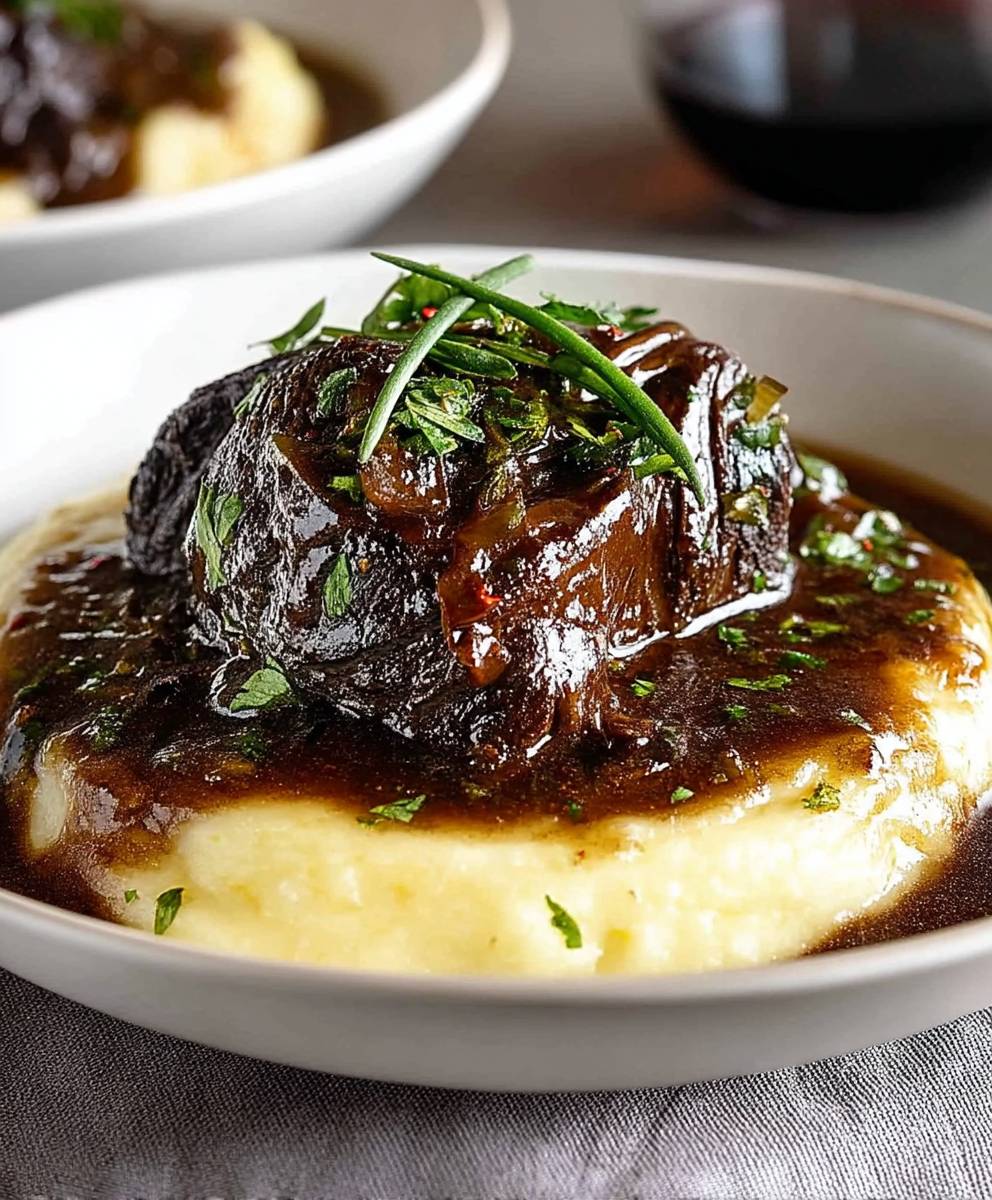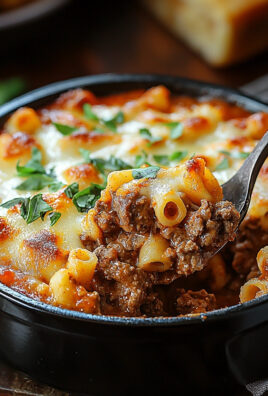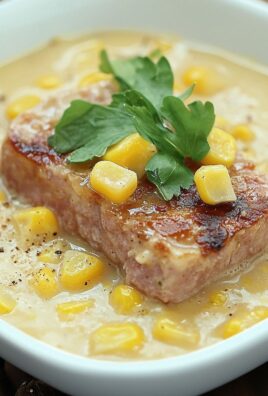Beef Cheeks Red Wine Sauce: Prepare to be transported to a world of culinary delight with this incredibly tender and flavorful dish. Imagine sinking your fork into melt-in-your-mouth beef, braised to perfection in a rich, deeply satisfying red wine sauce. This isn’t just a meal; it’s an experience!
Braised beef cheeks, often considered a humble cut, have a long and storied history in European cuisine, particularly in France and Italy. Traditionally, these cuts were favored for their affordability and incredible depth of flavor when cooked low and slow. They represent a resourceful approach to cooking, transforming a tougher cut into a delicacy. For generations, families have passed down their secret recipes, each adding their own unique touch to this classic dish.
What makes Beef Cheeks Red Wine Sauce so irresistible? It’s the perfect combination of textures and tastes. The beef cheeks become unbelievably tender, practically dissolving in your mouth, while the red wine sauce, infused with aromatic herbs and vegetables, creates a symphony of savory flavors. People love this dish because it’s both comforting and elegant, perfect for a special occasion or a cozy night in. Plus, while the braising process takes time, it’s surprisingly hands-off, making it a convenient option for a weekend feast. Get ready to impress your family and friends with this unforgettable culinary creation!
Ingredients:
- Beef Cheeks: 2 kg, trimmed of excess fat
- Olive Oil: 3 tablespoons, extra virgin
- Onion: 2 large, finely chopped
- Carrots: 2 large, peeled and chopped
- Celery: 2 stalks, chopped
- Garlic: 4 cloves, minced
- Tomato Paste: 3 tablespoons
- Dry Red Wine: 750ml bottle (e.g., Cabernet Sauvignon, Merlot, or Chianti)
- Beef Broth: 500ml, low sodium
- Bay Leaves: 2
- Fresh Thyme: 4 sprigs
- Fresh Rosemary: 2 sprigs
- All-Purpose Flour: 2 tablespoons
- Balsamic Vinegar: 1 tablespoon
- Worcestershire Sauce: 1 tablespoon
- Salt: To taste
- Black Pepper: Freshly ground, to taste
- Optional: 100g Pancetta or Bacon, diced
- Optional: 1 tbsp Butter, unsalted
Preparing the Beef Cheeks:
- Prepare the Beef: First, pat the beef cheeks dry with paper towels. This is crucial for getting a good sear. Season them generously with salt and freshly ground black pepper. Don’t be shy with the seasoning; it’s the foundation of the flavor.
- Sear the Beef: Heat the olive oil in a large, heavy-bottomed pot or Dutch oven over medium-high heat. You want the oil to be shimmering but not smoking. If you’re using pancetta or bacon, add it to the pot first and cook until crispy, then remove and set aside, leaving the rendered fat in the pot. Working in batches (don’t overcrowd the pot!), sear the beef cheeks on all sides until they are deeply browned. This step is essential for developing a rich, flavorful crust. Remove the seared beef cheeks from the pot and set aside.
Building the Aromatic Base:
- Sauté the Vegetables: Reduce the heat to medium. Add the chopped onion, carrots, and celery to the pot. Sauté until the vegetables are softened and slightly caramelized, about 8-10 minutes. Stir frequently to prevent burning. The goal here is to build a flavorful base for the sauce.
- Add Garlic and Tomato Paste: Add the minced garlic and tomato paste to the pot. Cook for another 2-3 minutes, stirring constantly, until the garlic is fragrant and the tomato paste has deepened in color. This step helps to intensify the flavors of both ingredients.
- Deglaze the Pot: Pour in the red wine, scraping up any browned bits from the bottom of the pot. These browned bits, called fond, are packed with flavor and will add depth to the sauce. Bring the wine to a simmer and let it reduce by about half, which should take about 5-7 minutes. This concentrates the wine’s flavor and removes some of the alcohol.
Braising the Beef Cheeks:
- Combine Ingredients: Return the seared beef cheeks to the pot. Add the beef broth, bay leaves, thyme sprigs, and rosemary sprigs. Make sure the beef cheeks are mostly submerged in the liquid. If needed, add a little more beef broth or water.
- Bring to a Simmer: Bring the mixture to a simmer, then cover the pot tightly with a lid.
- Braise in the Oven: Transfer the pot to a preheated oven at 160°C (320°F). Braise for 3-3.5 hours, or until the beef cheeks are incredibly tender and easily fall apart when pierced with a fork. The braising time may vary depending on the size and thickness of the beef cheeks. Check them periodically to ensure they are not drying out; if necessary, add a little more broth.
Refining the Sauce:
- Remove the Beef Cheeks: Once the beef cheeks are tender, carefully remove them from the pot and set aside.
- Strain the Sauce: Strain the braising liquid through a fine-mesh sieve into a separate saucepan. Discard the solids (vegetables, herbs, and bay leaves).
- Thicken the Sauce (Optional): In a small bowl, whisk together the all-purpose flour with a few tablespoons of cold water to create a slurry. Bring the strained sauce to a simmer over medium heat. Gradually whisk in the flour slurry, a little at a time, until the sauce reaches your desired consistency. Be careful not to add too much slurry, as it can make the sauce too thick. Alternatively, for a richer sauce, you can skip the flour slurry and reduce the sauce further by simmering it over medium heat until it thickens naturally.
- Finish the Sauce: Stir in the balsamic vinegar and Worcestershire sauce. Taste the sauce and adjust the seasoning with salt and pepper as needed. For an extra touch of richness, whisk in a tablespoon of unsalted butter at the end.
Serving:
- Shred the Beef: Using two forks, gently shred the beef cheeks into bite-sized pieces.
- Combine and Serve: Return the shredded beef cheeks to the sauce and stir to combine. Heat through gently. Serve the beef cheeks and red wine sauce over mashed potatoes, creamy polenta, egg noodles, or crusty bread. Garnish with fresh parsley or thyme, if desired. You can also serve it with roasted root vegetables like parsnips and carrots.
Tips for Success:
- Quality Ingredients: Use high-quality beef cheeks and red wine for the best flavor.
- Proper Searing: Don’t skip the searing step! It’s crucial for developing a rich, flavorful crust on the beef cheeks.
- Low and Slow: Braising the beef cheeks at a low temperature for a long time is key to achieving maximum tenderness.
- Adjust Seasoning: Taste the sauce frequently and adjust the seasoning as needed.
- Make Ahead: This dish can be made a day or two in advance. The flavors will actually improve as it sits. Simply reheat gently before serving.
Variations:
- Add Mushrooms: Sauté sliced mushrooms along with the onions, carrots, and celery for an earthier flavor.
- Add Orange Zest: A little orange zest can brighten up the sauce and add a subtle citrus note.
- Spice it Up: Add a pinch of red pepper flakes to the sauce for a touch of heat.
- Use Different Herbs: Experiment with different herbs, such as oregano or marjoram.

Conclusion:
And there you have it! This Beef Cheeks Red Wine Sauce recipe isn’t just another dish; it’s an experience. It’s the kind of meal that transforms an ordinary evening into something truly special. The melt-in-your-mouth tenderness of the beef cheeks, combined with the rich, deeply flavorful red wine sauce, is a symphony of textures and tastes that will leave you utterly satisfied. I truly believe this is a must-try recipe for anyone who appreciates slow-cooked comfort food at its finest.
Why is it a must-try? Because it’s surprisingly simple to make, despite its impressive results. The slow cooking process does all the hard work, allowing the flavors to meld and deepen over time. It’s also incredibly versatile. While I’ve presented it with a classic red wine sauce, the possibilities are endless. Imagine adding a touch of balsamic vinegar for a hint of sweetness, or a sprinkle of smoked paprika for a smoky depth. Feel free to experiment and make it your own!
Speaking of versatility, let’s talk serving suggestions. My personal favorite is to serve these succulent beef cheeks over a bed of creamy mashed potatoes. The richness of the sauce perfectly complements the smooth, comforting potatoes. But don’t stop there! Polenta is another fantastic option, providing a slightly coarser texture that contrasts beautifully with the tender beef. You could also serve it with wide egg noodles, allowing the sauce to cling to every strand. For a lighter option, consider serving it alongside roasted root vegetables like carrots, parsnips, and sweet potatoes. The sweetness of the vegetables will balance the richness of the sauce.
And for variations? Oh, the possibilities! If you’re not a fan of red wine, you could substitute it with a dark beer like stout or porter. This will give the sauce a slightly different flavor profile, adding a malty depth. You could also add some dried mushrooms to the sauce for an earthy umami boost. Or, for a spicier kick, add a pinch of red pepper flakes. Don’t be afraid to get creative and tailor the recipe to your own taste preferences.
I’m so confident that you’ll love this recipe that I urge you to try it. Seriously, clear your schedule, gather your ingredients, and prepare to be amazed. The aroma that will fill your kitchen as the beef cheeks slowly braise is intoxicating, and the first bite will be pure bliss.
But the best part of cooking, in my opinion, is sharing the experience. So, once you’ve made this incredible Beef Cheeks Red Wine Sauce, I’d love to hear about it! Did you make any variations? What did you serve it with? What did your family and friends think? Share your photos and stories with me in the comments below. I can’t wait to see what culinary masterpieces you create! Cooking is a journey, and I’m thrilled to be a part of yours. Happy cooking! I hope this recipe becomes a staple in your home, bringing joy and deliciousness to your table for years to come. Don’t hesitate to reach out if you have any questions along the way. I’m here to help you succeed in the kitchen and create unforgettable meals. Now go forth and braise those beef cheeks! You won’t regret it.
Beef Cheeks Red Wine Sauce: A Delicious & Tender Recipe
Tender beef cheeks braised in a rich red wine sauce with aromatic vegetables and herbs. A comforting and flavorful dish perfect for a special occasion or cozy night in.
Ingredients
- 2 kg Beef Cheeks, trimmed of excess fat
- 3 tablespoons Olive Oil, extra virgin
- 2 large Onions, finely chopped
- 2 large Carrots, peeled and chopped
- 2 stalks Celery, chopped
- 4 cloves Garlic, minced
- 3 tablespoons Tomato Paste
- 750ml bottle Dry Red Wine (e.g., Cabernet Sauvignon, Merlot, or Chianti)
- 500ml Beef Broth, low sodium
- 2 Bay Leaves
- 4 sprigs Fresh Thyme
- 2 sprigs Fresh Rosemary
- 2 tablespoons All-Purpose Flour
- 1 tablespoon Balsamic Vinegar
- 1 tablespoon Worcestershire Sauce
- Salt, to taste
- Black Pepper, Freshly ground, to taste
- 100g Pancetta or Bacon, diced (Optional)
- 1 tbsp Butter, unsalted (Optional)
Instructions
- Pat the beef cheeks dry with paper towels. Season generously with salt and freshly ground black pepper.
- Heat olive oil in a large, heavy-bottomed pot or Dutch oven over medium-high heat. If using pancetta or bacon, cook until crispy, remove, and set aside. Sear beef cheeks in batches on all sides until deeply browned. Remove and set aside.
- Reduce heat to medium. Add onion, carrots, and celery to the pot. Sauté until softened and slightly caramelized, about 8-10 minutes.
- Add garlic and tomato paste to the pot. Cook for 2-3 minutes, stirring constantly, until fragrant and the tomato paste has deepened in color.
- Pour in red wine, scraping up any browned bits from the bottom of the pot. Bring to a simmer and let it reduce by about half (5-7 minutes).
- Return seared beef cheeks to the pot. Add beef broth, bay leaves, thyme sprigs, and rosemary sprigs. Ensure beef cheeks are mostly submerged.
- Bring the mixture to a simmer, then cover the pot tightly with a lid.
- Transfer the pot to a preheated oven at 320°F (160°C). Braise for 3-3.5 hours, or until beef cheeks are incredibly tender. Check periodically and add more broth if needed.
- Carefully remove beef cheeks from the pot and set aside.
- Strain braising liquid through a fine-mesh sieve into a separate saucepan. Discard solids.
- Whisk together flour with a few tablespoons of cold water to create a slurry. Bring the strained sauce to a simmer over medium heat. Gradually whisk in the flour slurry, a little at a time, until the sauce reaches your desired consistency. Alternatively, for a richer sauce, you can skip the flour slurry and reduce the sauce further by simmering it over medium heat until it thickens naturally.
- Stir in balsamic vinegar and Worcestershire sauce. Taste and adjust seasoning with salt and pepper. For extra richness, whisk in butter.
- Using two forks, gently shred the beef cheeks into bite-sized pieces.
- Return shredded beef cheeks to the sauce and stir to combine. Heat through gently. Serve over mashed potatoes, creamy polenta, egg noodles, or crusty bread. Garnish with fresh parsley or thyme, if desired.
Notes
- Use high-quality beef cheeks and red wine for the best flavor.
- Don’t skip the searing step! It’s crucial for developing a rich, flavorful crust on the beef cheeks.
- Braising the beef cheeks at a low temperature for a long time is key to achieving maximum tenderness.
- Taste the sauce frequently and adjust the seasoning as needed.
- This dish can be made a day or two in advance. The flavors will actually improve as it sits. Simply reheat gently before serving.






Leave a Comment